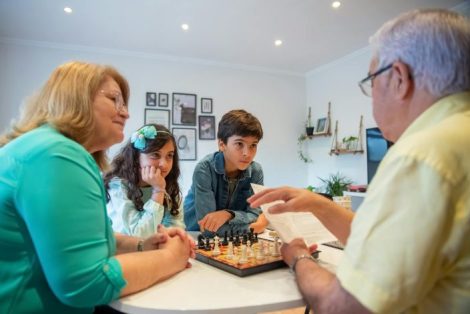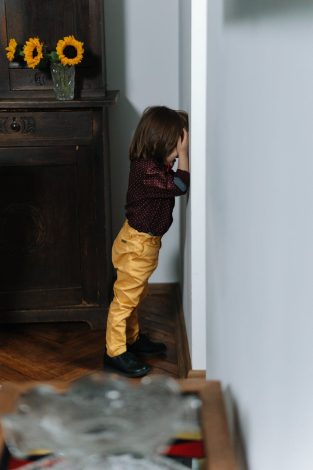It’s 8 pm, and your daughter is sprawled on the floor, surrounded by books and toys. She hasn’t brushed her teeth or put on her pajamas. She knows she’s supposed to be getting ready for bed! But is your daughter being defiant, or is she distracted? Moments like this are where positive discipline ADHD strategies can make all the difference.
You’re tired of constantly nagging her for the same things. It’s like Groundhog Day. But she doesn’t “get it.” She knows she will get fussed at, so why doesn’t she just do what you ask? Nagging, scolding, and punishing aren’t working, so what can you do?
In this blog, you’ll learn why traditional punishments are counterintuitive. And you’ll discover what you can do instead to help your daughter make real behavioral changes—without harsh punishments or nagging.
Why traditional punishment methods don’t work with ADHD
Here’s the thing— traditional punishments don’t work with ADHD kids. First of all, ADHD is a neurodevelopmental disorder, not a behavior problem. Your daughter’s brain responds to different stimuli; she isn’t intentionally choosing to misbehave. She naturally seeks out activities that stimulate dopamine and avoids boring, repetitive, or hard tasks. They certainly don’t produce dopamine! And that creates conflicts with you and with other adults.
She’s used to punishments
I grew up on a military base, and jets constantly flew overhead. In the middle of town, there was a sign that said, “Pardon our Noise, It’s the Sound of Freedom.” Now, decades later, I barely notice if an airplane roars overhead. Because I got used to it. The same can happen when your daughter constantly hears negative messages or loud voices. It becomes normal for her, and she blocks them out.

Your daughter seems to live in her own world, and you have to raise your voice just to get a response from her. It doesn’t faze her, so what can you do? You’re her parent. You must set limits for your daughter and occasionally say no to her. After all, you want her to stay safe and learn how to cooperate. But when you’re firing off a constant barrage of “no,” “you can’t do that,” and “stop that,” it’s just noise to your daughter. She continues doing what she likes, knowing you’ll raise your voice when you’re “serious.” Until then, she’s going to push the limits.
When you finally lose your patience and snap, you’re not in control of the situation. You’re upset and more likely to get into an argument or power struggle. And in the heat of the moment, you might say things you regret or punish her more harshly.
“If you shout at your ADHD child, you’re setting up a bad cycle…We [unfairly] expect kids to be able to do things that grown-ups don’t even do well.”
~~ Patricia Sung, ADHD coach, speaker, and podcast host
How typical punishments can harm ADHD kids: punishment reinforces the belief that she’s “bad”
Punishment is focused on external behaviors instead of internal causes. The focus on bad behaviors can be problematic for young kids who have trouble separating their identities from their behaviors. This is especially true for ADHD kids, who are already highly sensitive. Harsh words or punishment can reinforce your daughter’s feelings that she’s “bad” or “too much.” Remember, she isn’t acting out on purpose, and when she’s defined by behaviors she can’t control, she feels powerless. She wonders why she can’t do better, and her self-esteem suffers from repeated punishments and reprimands.
No guidance for future behavior
The other problem with punishment is that it focuses only on the past—what your daughter did wrong. For example, you take away your daughter’s screen privileges for a week because she forgot to do her homework. Your daughter won’t like it, but she isn’t going to learn anything. In fact, she might start to hide things to avoid “getting in trouble.” Punishments give her nothing to build on. She needs to know what to do instead. If you want behavior changes to stick, she needs guidance for the future.
Use discipline instead of punishment
That’s where discipline comes in. There are still consequences for your daughter’s behavior, but they fit the situation and make sense. For example, instead of having no TV for a week, she can’t watch it until her homework is finished and you check it. That addresses the problem and reinforces the behaviors you want to see.
Unlike punishment, discipline uses natural and logical consequences that help your daughter understand her actions. It focuses on what she can do right instead of what she did wrong.

Natural consequences
You don’t set natural consequences. They happen, well, naturally. As long as it’s safe, and your daughter has the maturity to understand them—let them happen. Of course, you should intervene if your daughter is doing something dangerous, like playing in the street. But otherwise, let her learn from natural consequences.
For example, if your seven-year-old daughter refuses to wear a jacket on a chilly day, she’ll be cold. That’s a natural consequence, and she’s old enough to understand it. So, let her be uncomfortable. Afterward, empathize with her and talk about what happened. She can see her actions led to an unpleasant outcome. This helps her connect cause and effect and learn by experience.
It’s important to let your daughter make mistakes. If you bring a coat for her, she won’t be uncomfortable, but what happens the next time she doesn’t want to wear a coat? She knows you’ll provide one for her. She’s not learning the skills for real-world independence. Instead, she’s relying on you to keep her life in order. Truly supporting your daughter means teaching her to take responsibility for her actions as she grows.
“Kids don’t want to fail. They don’t want to be stuck. But they need to know we believe they’re capable of handling it. And if we keep stepping in every time, they never learn that for themselves.”
~~Ned Johnson, ADHD and autism coach, author
Logical consequences
You don’t have a hand with natural consequences other than letting them happen. On the other hand, you set logical consequences. Take this house rule, for example: if you make a mess, you clean up the mess. So, if your daughter splashes water on the floor during bathtime, she has to clean it. That isn’t a punishment; it’s a logical consequence. Can’t argue with that! She knew the rules, and she was in control of her behavior. When she breaks the rule, she gets the outcome that comes with breaking that rule. It’s a fair and simple cause-and-effect equation. It also corrects the behavior you don’t want while reinforcing the behavior you want to see.
Natural and logical consequences can occur together, too. For example, if your daughter doesn’t do her homework despite several reminders, she’ll be unprepared at school. She might be embarrassed or do poorly on a test. That’s a natural consequence. Coupled with that, you can employ a logical consequence of taking away screen time until her homework is done. Natural and logical consequences create a powerful combo to guide future behavior when applied together.
You can respond instead of react
To be fair, consequences should be explained to the child in advance. If you do such and such, this will be the consequence. This ensures you’re not punishing your daughter out of anger or frustration. Because let’s face it: sometimes, your daughter will push every button you have. Twice. It’s frustrating, and she can seem like the enemy. But take a deep breath. Logical consequences are very clear; there’s no need to yell or escalate threats of punishment. As you continue to calmly impose consequences, she adjusts her behavior. Your daughter can rely on it. And so can you.
Considerations for consequences

To be effective, consequences need to meet a few simple requirements.
Clear
Create a few simple house rules that everyone in your family must follow—no exceptions, no justifications. They leave no room for argument. For example, you could make a house rule of no tablets or phones at the dinner table. If your daughter uses a phone during dinner, she loses her screen privileges for the day. In other words, expectations should be clear, and consequences shouldn’t be a surprise. When your daughter is aware of house rules and what happens when she breaks them, she feels more in charge. She knows what’s coming if she misbehaves.
Fitting
Consequences aren’t designed to punish. They help connect the dots between what your daughter did and what she should do. For example, don’t take away her playtime if she forgets to do her homework. That’s a big punishment and doesn’t connect to the outcome you want—finished homework. A fair and fitting consequence of unfinished homework is that she can’t play until it’s done. When behaviors lead to consequences that make sense, the lesson sticks.
Applied quickly
Consequences should happen at or near the time of the misbehavior. ADHD kids have a hard time remembering what happened and connecting consequences to their actions. Addressing things in the moment keeps expectations clear and the consequences meaningful.
Consistent
Enforce the house rule consequences every time. No exceptions. If your daughter pulls out her tablet during dinner, she loses it for 24 hours. While consequences can seem harsh, they reinforce fairness and teach accountability.
Your daughter knows you mean what you say. No tablet at the dinner table means no tablet at the dinner table. It will be taken away. No exceptions or arguments; it just happens. Your daughter might try to plead her case but stay resolute. Because if you occasionally cave to your daughter’s cajoling, she learns to cajole every time until you give in. Be gentle but firm, and don’t give her a maybe. By calmly enforcing rules and consequences over time, your daughter learns that you don’t change your mind.
Consequences set the stage for accountability
Your daughter probably has a reason or excuse for bad behavior—she only called her brother a name because he was annoying her! Okay, but if you have a house rule of no name-calling, that’s no excuse. Equitable rules and consistent outcomes create a culture of accountability and respect. So, if she calls her brother a name, she receives the consequence, no matter what. This helps her understand and take responsibility for her actions.
To help your daughter avoid consequences and learn what to do, brainstorm with her what actions she could take before she breaks a rule. For instance, if her brother is upsetting her, she could walk away, count to 10, etc. She learns that it’s her responsibility to control her behavior instead of trying to justify it.
A different approach to timeout
Sometimes, your daughter needs a timeout. For example, she hits another child. You can remove her from the situation and give her time to cool down. But timeouts shouldn’t be used as a threat or a punishment. The thing is, sending your child to the corner because they were “bad” can trigger feelings of rejection, isolation, and shame, especially in ADHD kids. With this in mind, consider a timeout as a calming intervention instead of a punishment. This is a time for your daughter to calm down, so what helps her do that?

Here are a few things to remember when deciding how to handle timeouts in your family.
Kids with ADHD benefit from co-regulation and support. So, instead of a timeout, consider a time-in. In other words, instead of sending your daughter away to calm down, keep her close to you. Model calm emotions and help her work through her feelings. Let her know you love her and that she’s safe.
If movement calms your daughter down, use that! Take a brief walk or do some jumping jacks. It’s okay if your daughter enjoys the exercise; remember, timeouts are for regulation and support, not punishment.
Whatever type of timeout you choose should be short; the length needs to be equal to or less than your daughter’s age. For example, if she’s six, give a 6-minute or shorter timeout. Use a timer or countdown clock to show your daughter how much time is left in timeout. She feels more in control and doesn’t need to keep asking how much time is left; she can see it!
Also, remember that your daughter is developmentally about 2 to 3 years behind other children. In other words, your seven-year-old daughter may have the maturity of a 5-year old. You can adjust timeout lengths accordingly.
After the timeout, have a quick conversation to reconnect with your daughter. Recap the behavior without shame or blame, and discuss what she can do in the future. Finally, reassure her that although she did a bad thing, she isn’t bad and that you love her no matter what.
You got this
You’re not a terrible parent because you tried punishments, and your daughter isn’t a bad kid because they didn’t work. The thing is, you don’t have a how-to manual on raising your ADHD daughter. But now you know that you need to address how her brain works first and her behavior second. Discipline gives her the guidance and structure she needs to change her behavior. It allows you to correct and guide your daughter while providing the safe, supportive, and loving space she needs.
Liked this? We know you’ll love: Positive parenting techniques for children with ADHD: building confidence through consistency and encouragement
About the Author

Alex Alcon
Alex Alcon, RN, Freelance nurse content and copywriter, owner of RN2Pen LLC.

Cynthia Hammer, MSW
Cynthia Hammer, MSW, is an ADHD advocate helping girls get timely diagnoses. She's the founder of FINDtheADHDgirls, Executive Director of Inattentive ADHD Coalition, and author of Living with Inattentive ADHD.

